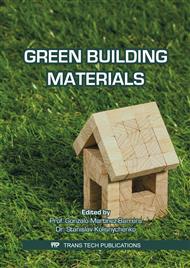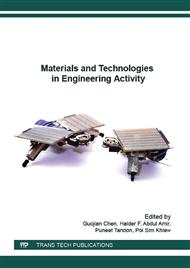p.68
p.73
p.78
p.82
p.89
p.94
p.99
p.107
p.112
Mechanical and Thermal Properties of Brick Produced Using Recycled Fine Aggregate
Abstract:
Continuous reduction of construction mineral resources, such as sand and cement, which influence the increase in cost of raw materials, has stimulated initiatives to look for alternative sustainable materials. This research aims to determine the potential and feasibility use of recycled fine aggregate (RFA) generated from demolition waste rubble wall as aggregate to replace natural sand in the production of cement and sand bricks. The brick specimens are prepared by using 100% natural sand, which is then replaced by RFA at 25%, 50%, 75%, and 100% by weight of natural sand. Research parameters, such as dimension, compressive and flexural strength, density, and water absorption, are adopted to evaluate the physical and mechanical properties of the brick specimens. In addition, the thermal conductivity of the bricks composed using different RFA proportions are studied. Experimental results clearly indicate that manufacturing cement and sand brick by incorporating RFA is possible, and the effect inclusion of RFA at certain proportions causes a significant improvement in the mechanical properties of bricks. However, to obtain better mechanical strength results, RFA dosages to replace sand should reach up to 50%.
Info:
Periodical:
Pages:
112-116
Citation:
Online since:
August 2016
Authors:
Keywords:
Price:
Сopyright:
© 2016 Trans Tech Publications Ltd. All Rights Reserved
Share:
Citation:



